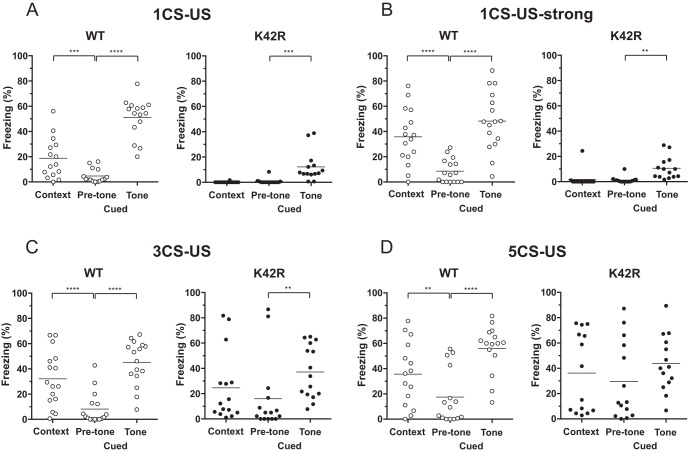Figure 4.
No context discrimination, whereas partially preserved cued fear memory after fear conditioning in the kinase-dead CaMKIIα (K42R)-KI mouse. A, Fear conditioned memory after a single-stimulation protocol with a 30-s tone that coterminated with a 0.3-mA footshock (1CS-US). Contextual fear memory (Context) was tested in the same conditioning chamber 24 h after conditioning. Cued fear memory (Cued) was tested in a different context without (Pre-tone) or with tone (Tone) 48 h after conditioning. Ordinate indicates percentage freezing time for the period of 180 s, and the line in each column expresses the mean. Left, Wild-type (WT) mice showed significantly longer freezing time in the contextual chamber than in the cued chamber without tone, demonstrating context-dependent fear memory. In addition, they showed significantly longer freezing time in the cued chamber with tone than without tone, demonstrating tone-dependent fear memory; n = 15. Right, CaMKIIα (K42R)-KI mice showed virtually no freezing in the contextual chamber, as well as in the cued chamber without tone, and there was no significant difference in freezing time between the two conditions. On the other hand, they showed rather small, but significant freezing in the cued chamber with tone, indicating that cued fear memory was formed at least to a certain extent; n = 14. B, Fear conditioned memory after a stronger single-stimulation protocol with a 0.7-mA footshock (1CS-US-strong). Basically, similar results were observed as in A. WT, n = 16 (left). K42R, n = 14 (right). C, Fear conditioned memory after a repeated-stimulation protocol with three pairings of a tone and a 0.3-mA footshock (3CS-US). Left, Wild-type mice showed both context-dependent and tone-dependent freezing; n = 16. Right, CaMKIIα (K42R)-KI mice showed increased freezing in all of the three conditions tested, but they still did not show context-dependent freezing, whereas showed tone-dependent freezing, revealing context discrimination deficits; n = 15. D, Fear conditioned memory after a repeated stimulation protocol with five pairings of a tone and a 0.3-mA footshock (5CS-US). Left, Wild-type mice again showed both context-dependent and tone-dependent freezing; n = 15. Right, CaMKIIα (K42R)-KI mice showed generally increased freezing, and there was no significant difference in percentage freezing time between the three conditions tested, revealing severe context discrimination deficits, leading to generalized fear; n = 14; **p < 0.01, ***p < 0.001, ****p < 0.0001, Bonferroni’s post hoc test.

